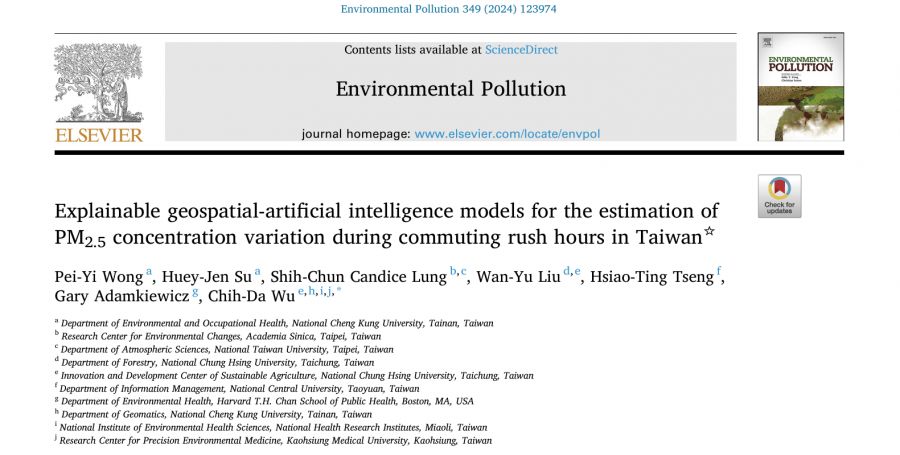生態農業:氣候變遷下森林碳匯與生態經濟評估【國立成功大學測量及空間資訊學系/吳治達教授】
| 論文篇名 | 英文:Explainable geospatial-artificial intelligence models for the estimation of PM2.5 concentration variation during commuting rush hours in Taiwan 中文:可解釋的地理空間人工智能模型,用於估算台灣通勤高峰時段PM2.5濃度的變化 |
| 期刊名稱 | Environmental Pollution |
| 發表年份,卷數,起迄頁數 | 2024, 349: 123974 |
| 作者 | Wong, Pei-Yi; Su, Huey-Jen; Lung, Shih-Chun Candice; Liu, Wan-Yu(柳婉郁); Tseng, Hsiao-Ting; Adamkiewicz, Gary; Wu, Chih-Da(吳治達)* |
| DOI | 10.1016/j.envpol.2024.123974 |
| 中文摘要 | 在背景站點,PM2.5 濃度在尖峰時段高於這些站點的平均濃度。鮮有研究使用機器學習模型調查PM2.5濃度及其在尖峰時段的空間分布。本研究運用地理空間人工智能(Geo-AI)預測模型,估算台灣早晨和傍晚尖峰時段的PM2.5濃度時空變化。從2006年到2020年,收集每小時的平均PM2.5測量值,並將其彙總為早晨(7 a.m.–9 a.m.)和傍晚(4 p.m.–6 p.m.)尖峰時段的平均濃度。Geo-AI預測模型通過整合克里金插值法、土地利用回歸、機器學習和堆疊集成方法生成。基於SHapley 加法解釋(SHAP)指數的前向逐步變量選擇方法被用來確定最具影響力的變量。研究結果顯示,Geo-AI模型對早晨和傍晚尖峰時段的預測準確度分別達到0.95和0.93,並經過驗證,表明模型具有穩健性。在空間上,早晨尖峰時段的PM2.5濃度在台灣西南部較高,而傍晚尖峰時段則在郊區較高。關鍵預測因子包括克里金插值的PM2.5值、SO2濃度、森林密度以及與焚化爐的距離。這些早晨和傍晚尖峰時段的PM2.5估算結果可支持發展低污染濃度的替代通勤路線。 |
| 英文摘要 | PM2.5 concentrations are higher during rush hours at background stations compared to the average concentration across these stations. Few studies have investigated PM2.5 concentration and its spatial distribution during rush hours using machine learning models. This study employs a geospatial-artificial intelligence (Geo-AI) prediction model to estimate the spatial and temporal variations of PM2.5 concentrations during morning and dusk rush hours in Taiwan. Mean hourly PM2.5 measurements were collected from 2006 to 2020, and aggregated into morning (7 a.m.–9 a.m.) and dusk (4 p.m.–6 p.m.) rush-hour mean concentrations. The Geo-AI prediction model was generated by integrating kriging interpolation, land-use regression, machine learning, and a stacking ensemble approach. A forward stepwise variable selection method based on the SHapley Additive exPlanations (SHAP) index was used to identify the most influential variables. The performance of the Geo-AI models for morning and dusk rush hours had accuracy scores of 0.95 and 0.93, respectively and these results were validated, indicating robust model performance. Spatially, PM2.5 concentrations were higher in southwestern Taiwan for morning rush hours, and suburban areas for dusk rush hours. Key predictors included kriged PM2.5 values, SO2 concentrations, forest density, and the distance to incinerators for both morning and dusk rush hours. These PM2.5 estimates for morning and dusk rush hours can support the development of alternative commuting routes with lower concentrations. |
| 發表成果與本中心研究主題相關性 | 本研究探討之主題著眼在地理人工智慧於環境汙染與永續環境管理之應用,模型中亦探討森林對細懸浮微粒汙染之影響,與本中心高度相關。 |







